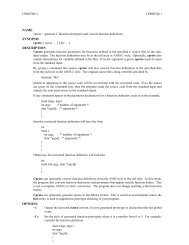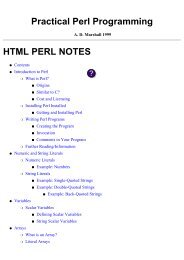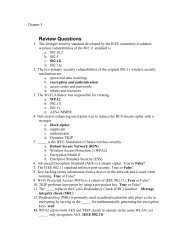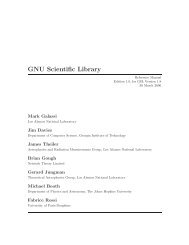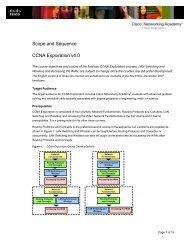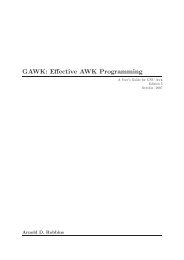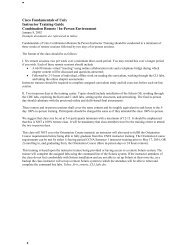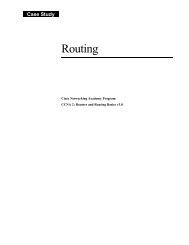Understanding and Configuring PPP CHAP ... - Cisco Academy
Understanding and Configuring PPP CHAP ... - Cisco Academy
Understanding and Configuring PPP CHAP ... - Cisco Academy
Create successful ePaper yourself
Turn your PDF publications into a flip-book with our unique Google optimized e-Paper software.
<strong>Underst<strong>and</strong>ing</strong> <strong>and</strong> <strong>Configuring</strong> <strong>PPP</strong> <strong>CHAP</strong>AuthenticationIntroductionBefore You BeginConventionsPrerequisitesComponents Used<strong>Configuring</strong> <strong>CHAP</strong>One−Way <strong>and</strong> Two−Way Authentication<strong>CHAP</strong> Configuration Comm<strong>and</strong>s <strong>and</strong> OptionsTransactional ExampleCallChallengeResponseVerificationResultTroubleshooting <strong>CHAP</strong>Related InformationIntroductionThe Challenge H<strong>and</strong>shake Authentication Protocol (<strong>CHAP</strong>) (defined in RFC 1994 ) verifies the identity of thepeer using a three−way h<strong>and</strong>shake. The following general steps are performed in <strong>CHAP</strong>:1. After the link establishment phase is complete, the authenticator sends a challenge message to thepeer.2. The peer responds with a value calculated using a one−way hash function (Message Digest 5 (MD5)).3. The authenticator checks the response against its own calculation of the expected hash value. If thevalues match, the authentication is successful. Otherwise, the connection is terminated.This authentication method depends on a "secret" known only to the authenticator <strong>and</strong> the peer. The secret isnot sent over the link. Although the authentication is only one−way, by negotiating <strong>CHAP</strong> in both directions,you can use the same secret set for mutual authentication.For more information on the advantages <strong>and</strong> disadvantages of <strong>CHAP</strong>, refer to RFC 1994 .Before You BeginConventionsFor more information on document conventions, see the <strong>Cisco</strong> Technical Tips Conventions.PrerequisitesReaders of this document should be knowledgeable of the following:• Enable <strong>PPP</strong> on the interface using the comm<strong>and</strong> encapsulation ppp.<strong>Cisco</strong> − <strong>Underst<strong>and</strong>ing</strong> <strong>and</strong> <strong>Configuring</strong> <strong>PPP</strong> <strong>CHAP</strong> Authentication
• You must be able to read <strong>and</strong> underst<strong>and</strong> the debug ppp negotiation comm<strong>and</strong> output. Refer to<strong>Underst<strong>and</strong>ing</strong> debug ppp negotiation Output for more information.• The <strong>PPP</strong> authentication phase does not begin until the Link Control Protocol (LCP) phase is complete<strong>and</strong> is in the open state. If the debug ppp negotiation comm<strong>and</strong> does not indicate that LCP is open,troubleshoot this issue before proceeding.Note: This document does not address MS−<strong>CHAP</strong> (Version 1 or Version 2). For more information onMS−<strong>CHAP</strong>, refer to the documents MS−<strong>CHAP</strong> Support <strong>and</strong> MS<strong>CHAP</strong> Version 2.Components UsedThis document is not restricted to specific software <strong>and</strong> hardware versions.<strong>Configuring</strong> <strong>CHAP</strong><strong>Configuring</strong> <strong>CHAP</strong> is fairly straightforward. For example, say you have two routers, left <strong>and</strong> right, connectedacross a network, as shown in the example below.Use the following steps as a guide to configure <strong>CHAP</strong> authentication:1. On the interface, issue the encapsulation ppp comm<strong>and</strong>.2. Enable the use of <strong>CHAP</strong> authentication on both routers with the ppp authentication chap comm<strong>and</strong>.3. Configure the usernames <strong>and</strong> passwords. To do so, issue the comm<strong>and</strong> username usernamepassword password , where username is the hostname of the peer.♦ Passwords must be identical at both ends.♦ The router name <strong>and</strong> password are casesensitive.Note: By default, the router uses its hostname to identify itself to the peer. However, this <strong>CHAP</strong>username can be changed using the comm<strong>and</strong> ppp chap hostname. Refer to <strong>PPP</strong> AuthenticationUsing the ppp chap hostname <strong>and</strong> ppp authentication chap callin Comm<strong>and</strong>s for more information.One−Way <strong>and</strong> Two−Way Authentication<strong>CHAP</strong> is defined as a one−way authentication method. However, using <strong>CHAP</strong> in both direction creates atwo−way authentication. Hence, with two−way <strong>CHAP</strong>, a separate three−way h<strong>and</strong>shake is initiated by eachside.<strong>Cisco</strong> − <strong>Underst<strong>and</strong>ing</strong> <strong>and</strong> <strong>Configuring</strong> <strong>PPP</strong> <strong>CHAP</strong> Authentication
In the <strong>Cisco</strong> <strong>CHAP</strong> implementation, by default, the called party must authenticate the calling party (unlessauthentication is completely turned off). Therefore, a one−way authentication initiated by the called party isthe minimum possible authentication. However, the calling party can also verify the identity of the calledparty, resulting in a two−way authentication.One−way authentication is often required when connecting to non−<strong>Cisco</strong> devices.For one−way authentication, configure the comm<strong>and</strong> ppp authentication chap callin on the calling router.The following table shows when to configure the callin option:AuthenticationTypeOne−way(unidirectional)Two−way(bidirectional)Client (calling)ppp authenticationchap callinppp authenticationchapNAS (called)pppauthenticationchappppauthenticationchapFor more information on implementing one−way authentication, refer to <strong>PPP</strong> Authentication Using the pppchap hostname <strong>and</strong> ppp authentication chap callin Comm<strong>and</strong>s.<strong>CHAP</strong> Configuration Comm<strong>and</strong>s <strong>and</strong> OptionsThe following table lists the <strong>CHAP</strong> comm<strong>and</strong>s <strong>and</strong> options:Comm<strong>and</strong>ppp authentication{chap | ms−chap |pap} [callin |default]ppp chap hostnameusernameppp chap passwordpasswordppp direction callin| callout | dedicatedDescriptionThis comm<strong>and</strong> enables localauthentication of the remote <strong>PPP</strong> peerwith This the comm<strong>and</strong> specified defines protocol. aninterface−specific <strong>CHAP</strong> hostname. Referto the document <strong>PPP</strong> AuthenticationUsing the ppp chap hostname <strong>and</strong> pppauthentication chap callin Comm<strong>and</strong>s formore information.This comm<strong>and</strong> defines aninterface−specific <strong>CHAP</strong> password.This comm<strong>and</strong> forces a call direction.The comm<strong>and</strong> is used when a router isconfused as to whether the call isincoming or outgoing (for example, whenconnected back−to−back or connected byleased lines <strong>and</strong> the Channel Service Unitor Data Service Unit (CSU/DSU) or<strong>Cisco</strong> − <strong>Underst<strong>and</strong>ing</strong> <strong>and</strong> <strong>Configuring</strong> <strong>PPP</strong> <strong>CHAP</strong> Authentication
ppp chap refuse[callin]ppp chap waitppp max−bad−authvalueppp chapsplitnamesppp chap ignoreusISDN Terminal Adapter (TA) areconfigured to dial).This comm<strong>and</strong> disables remoteauthentication by a peer (default enabled).With this comm<strong>and</strong>, <strong>CHAP</strong>authentication is disabled for all calls,meaning that all attempts by the peer toforce the user to authenticate using <strong>CHAP</strong>are refused.The callin option specifies that the routerrefuses to answer <strong>CHAP</strong> authenticationchallenges received from the peer, butstill requires the peer to answer any<strong>CHAP</strong> challenges the router sends.This comm<strong>and</strong> specifies that the callermust authenticate first (default enabled).This comm<strong>and</strong> specifies that the routerwill not authenticate to a peer requesting<strong>CHAP</strong> authentication until after the peerhas authenticated itself to the router.This comm<strong>and</strong> specifies the allowednumber of authentication retries (thedefault value is 0).This comm<strong>and</strong> configures apoint−to−point interface not to reset itselfimmediately after an authenticationfailure, but instead to allow a specifiednumber of authentication retries.This hidden comm<strong>and</strong> allows differenthostnames for a <strong>CHAP</strong> challenge <strong>and</strong>response (the default value is disabled).This hidden comm<strong>and</strong> ignores <strong>CHAP</strong>challenges with the local name (thedefault value is enabled).Transactional ExampleThe following diagrams show the series of events that occur during a <strong>CHAP</strong> authentication between tworouters. These do not represent the actual messages seen in the debug ppp negotiation comm<strong>and</strong> output. Formore information, refer to <strong>Underst<strong>and</strong>ing</strong> debug ppp negotiation Output.Call<strong>Cisco</strong> − <strong>Underst<strong>and</strong>ing</strong> <strong>and</strong> <strong>Configuring</strong> <strong>PPP</strong> <strong>CHAP</strong> Authentication
The following steps are shown in this diagram:1. The call comes in to 3640−1. The incoming interface is configured with the ppp authentication chapcomm<strong>and</strong>.2. LCP negotiates <strong>CHAP</strong> <strong>and</strong> MD5. For more information on determining this, refer to <strong>Underst<strong>and</strong>ing</strong>the debug ppp negotiation Output.3. A <strong>CHAP</strong> challenge from 3640−1 to the calling router is required on this call.ChallengeThis figure illustrates the following steps in the <strong>CHAP</strong> authentication between the two routers:1. A <strong>CHAP</strong> challenge packet is built with the following characteristics:♦ 01 = challenge packet type identifier.♦ ID = sequential number that identifies the challenge.♦ r<strong>and</strong>om = a reasonably r<strong>and</strong>om number generated by the router.♦ 3640−1 = the authentication name of the challenger.2. The ID <strong>and</strong> r<strong>and</strong>om values are kept on the called router.3. The challenge packet is sent to the calling router. A list of outst<strong>and</strong>ing challenges is maintained.Response<strong>Cisco</strong> − <strong>Underst<strong>and</strong>ing</strong> <strong>and</strong> <strong>Configuring</strong> <strong>PPP</strong> <strong>CHAP</strong> Authentication
This diagram illustrates the receipt <strong>and</strong> MD5 processing of the challenge packet from the peer. The routerprocesses the incoming <strong>CHAP</strong> challenge packet in the following manner:1. The ID value is fed into the MD5 hash generator.2. The r<strong>and</strong>om value is fed into the MD5 hash generator.3. The name 3640−1 is used to look up the password. The router looks for an entry matching theusername in the challenge. In this example, it looks for:username 3640−1 password pc14. The password is fed into the MD5 hash generator.The result is the one−way MD5−hashed <strong>CHAP</strong> challenge that will be sent back in the <strong>CHAP</strong>response.Response (continued)This diagram illustrates how the <strong>CHAP</strong> response packet sent to the authenticator is built. The following stepsare shown in this figure:1. The response packet is assembled from the following components:<strong>Cisco</strong> − <strong>Underst<strong>and</strong>ing</strong> <strong>and</strong> <strong>Configuring</strong> <strong>PPP</strong> <strong>CHAP</strong> Authentication
♦ 02 = <strong>CHAP</strong> response packet type identifier.♦ ID = copied from the challenge packet.♦ hash = the output from the MD5 hash generator (the hashed information from the challengepacket).♦ 766−1 = the authentication name of this device. This is needed for the peer to look up theusername <strong>and</strong> password entry needed to verify identity (this is explained in more detailbelow).2. The response packet is then sent to the challenger.VerificationThis diagram shows how the challenger processes the response packet. The <strong>CHAP</strong> response packet isprocessed (on the authenticator) in the following manner:1. The ID is used to find the original challenge packet.2. The ID is fed into the MD5 hash generator.3. The original challenge r<strong>and</strong>om value is fed into the MD5 hash generator.4. The name 766−1 is used to look up the password from one of the following sources:Result♦ Local username <strong>and</strong> password database.♦ RADIUS or TACACS+ server.5. The password is fed into the MD5 hash generator.6. The hash value received in the response packet is then compared to the calculated MD5 hash value.<strong>CHAP</strong> authentication succeeds if the calculated <strong>and</strong> the received hash values are equal.<strong>Cisco</strong> − <strong>Underst<strong>and</strong>ing</strong> <strong>and</strong> <strong>Configuring</strong> <strong>PPP</strong> <strong>CHAP</strong> Authentication
This diagram illustrates the success message being sent to the calling router.1. If authentication is successful, a <strong>CHAP</strong> success packet is built from the following components:2.3.♦ 03 = <strong>CHAP</strong> success message type.♦ ID = copied from the response packet.♦ Welcome in is simply a text message providing a user−readable explanation.If authentication fails, a <strong>CHAP</strong> failure packet is built from the following components:♦ 04 = <strong>CHAP</strong> failure message type.♦ ID = copied from the response packet.♦ Authentication failure or other text message, providing a user−readable explanation.The success or failure packet is then sent to the calling router.Note: This example depicts a one−way authentication. In a two−way authentication, this entireprocess is repeated, however the calling router initiates the initial challenge.Troubleshooting <strong>CHAP</strong>Refer to Troubleshooting <strong>PPP</strong> Authentication for troubleshooting information.Related Information• <strong>Underst<strong>and</strong>ing</strong> debug ppp negotiation Output• Troubleshooting <strong>PPP</strong> Authentication• <strong>PPP</strong> Authentication Using the ppp chap hostname <strong>and</strong> ppp authentication chap callinComm<strong>and</strong>s• Access Technology Support Pages• Tools <strong>and</strong> Utilities − <strong>Cisco</strong> Systems• Technical Support − <strong>Cisco</strong> SystemsAll contents are Copyright © 1992−2003 <strong>Cisco</strong> Systems, Inc. All rights reserved. Important Notices <strong>and</strong> Privacy Statement.<strong>Cisco</strong> − <strong>Underst<strong>and</strong>ing</strong> <strong>and</strong> <strong>Configuring</strong> <strong>PPP</strong> <strong>CHAP</strong> Authentication



